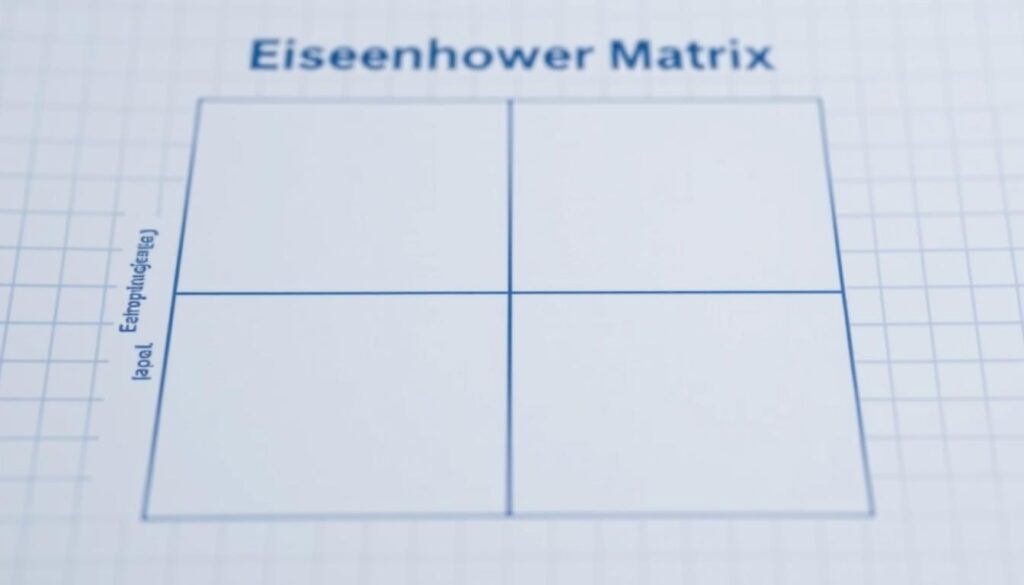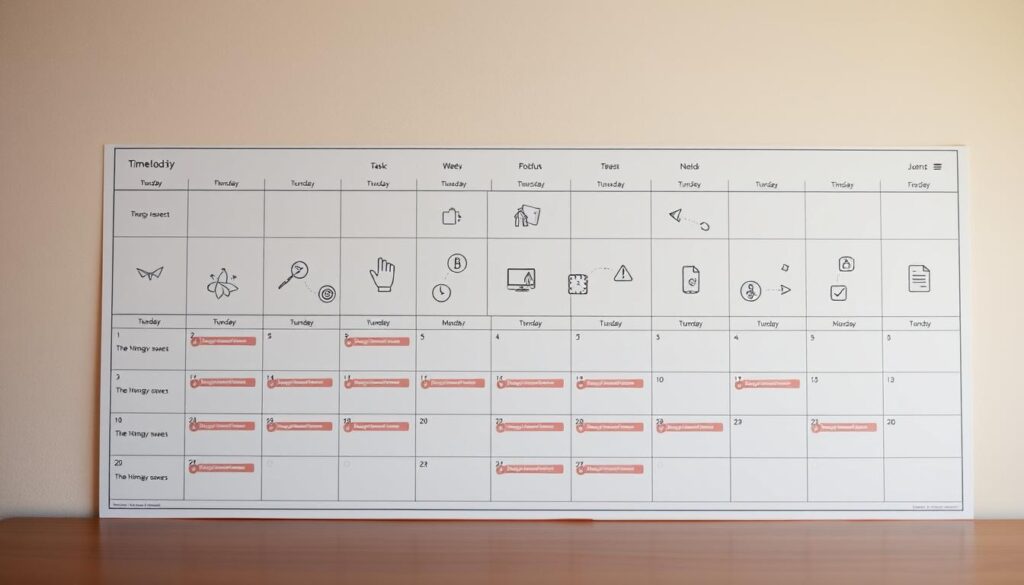Imagine you’re racing against time, handling client calls, deadlines, and family duties. You’re not alone. Almost 75% of U.S. workers feel burned out, and 42% of small-business owners faced burnout last year. As entrepreneurs, we know time is our most valuable asset. Every minute spent on non-essential tasks, like endless emails or scrolling, takes away from what’s truly important.
Entrepreneur time management hacks aren’t just about doing more in a day. They’re about picking what to focus on to grow your business and improve your life. The Pareto Principle (the 80/20 rule) shows us that 20% of our efforts lead to 80% of our results. Think about using that energy for actions that really matter. Time management for entrepreneurs is not just a strategy—it’s a lifeline to success and clarity.
Key Takeaways
- Effective time management can boost productivity by up to 25%, per studies.
- Entrepreneurs who track time in 15-minute chunks see clearer productivity patterns.
- Delegating tasks frees 30% of your time for critical decisions.
- Time-blocking improves focus by 20%, while multitasking cuts productivity by 40%.
- Over 60% of entrepreneurs rely on project management tools to streamline workflows.
Understanding Time Management in Entrepreneurship
Time management for entrepreneurs is more than just filling calendars. It’s about turning chaotic days into chances for growth. Solopreneurs need to master time management to stay on track with their goals and adapt to business needs.
What is Time Management?
Time management is about organizing tasks to meet business goals. Entrepreneurs use tools like Trello or Monday.com to keep track and share updates. This helps avoid feeling overwhelmed.
It’s important to focus on big tasks first, not just routine work. For example, spending eight hours on key tasks like getting a business registration number helps keep things moving forward.
Importance of Time Management for Entrepreneurs
Good time management is key for solopreneurs to succeed. Here are some reasons why:
- Focus: 30% more productivity comes from focusing on important tasks
- Health: Taking short breaks every 20 minutes helps avoid burnout
- Clarity: 25% of overwhelmed entrepreneurs see improvement with systems
| Benefit | Impact |
|---|---|
| Stress Reduction | 70% report better mental health with time blocks |
| Team Efficiency | 25% fewer project delays via clear communication |
| Time Savings | 15 hours weekly freed via automation tools |
As Zenjump highlights, time management linked with self-care boosts happiness. Entrepreneurs who use these strategies avoid the loss of 40% productivity from multitasking. They also gain control over their businesses.
Common Time Management Challenges
Entrepreneurs face daily battles with time thieves that steal focus and productivity. With 82% lacking structured time management for entrepreneurs, these obstacles often lead to burnout. Over 80% work overtime weekly, yet 51% of work hours go to low-value tasks. Let’s break down these hurdles and solutions.
Identifying Time Wasters
Start by auditing how you spend hours. Common pitfalls include:
- Unplanned meetings
- Social media scrolling
- Email overload
- Perfectionism delaying action
Use tools like RescueTime to track digital habits and pinpoint inefficiencies.
Overcoming Procrastination
Procrastination often stems from fear or overwhelm. Try these productivity tips for business owners:
- Break tasks into 5-minute chunks
- Use the “2-minute rule” for small tasks
- Set a 10-minute timer to start a project
Studies show 50% of procrastination stems from uncertainty—start small to build momentum.
Managing Distractions
External distractions like notifications and internal ones like doubt demand intentional solutions. Block distracting websites with the SelfControl app and schedule “focus hours” free of interruptions. Mental clutter? Try 5-minute breathing exercises to reset focus. Small steps add’t management for entrepreneurs can turn daily chaos into consistency.
Setting Clear Goals
Entrepreneurs who set clear goals are 50% more likely to achieve their goals. Productivity tips for business owners stress the importance of balancing immediate actions with long-term vision. Time management techniques for entrepreneurs start with turning big dreams into doable steps.
Begin by setting both short-term and long-term goals. Short-term goals, like getting five new clients this month, keep you motivated every day. Long-term goals, like opening a second store in two years, help guide your strategic decisions. Both need to be specific to avoid wasting time.
Short-term vs. Long-term Goals
Short-term goals, like finishing a website redesign this quarter, keep you moving forward. Long-term goals, like expanding into new markets in three years, require patience. For example, a restaurant owner might work on improving Yelp ratings (short-term) while planning to add a food truck (long-term). Check your progress weekly to stay on track.
SMART Goals Framework
Use this framework to set achievable targets:
- Specific: “Increase website traffic by 20% through targeted SEO campaigns”
- Measurable: Track progress via Google Analytics weekly
- Attainable: Break big goals into smaller weekly tasks
- Relevant: Make sure goals match your business values (e.g., eco-friendly packaging for a green brand)
- Time-bound: Set deadlines like “Finalize product launch by Q3”
Check your goals monthly with tools like Trello. Being flexible is key—adjust timelines as needed while staying focused. This approach ensures your time management stays effective. Studies show it boosts task completion by 25%.
Prioritization Techniques
Good time management starts with clear priorities. Entrepreneurs need to prioritize tasks for entrepreneurs to tackle important work. The Eisenhower Matrix and ABCDE methods are great for sorting tasks.

| Quadrant | Action | Examples |
|---|---|---|
| Urgent & Important | Do First | Crisis management, client emergencies |
| Important but Not Urgent | Schedule | Long-term planning, skill development |
| Urgent but Not Important | Delegate | Reports, routine emails |
| Neither | Eliminate | Unnecessary meetings, low-value tasks |
ABCDE Method: Use Brian Tracy’s system to set priorities:
| Priority | Description | Time Allocation |
|---|---|---|
| A | Must do (critical consequences) | 20-30% |
| B | Should do (moderate consequences) | 30-40% |
| C | Nice to do (no consequences) | 20-25% |
| D | Delegate | 5% |
| E | Eliminate | N/A |
Use tools like Productboard or Todoist to keep track. Spend 20–30% of your week on A-priority tasks. This boosts growth. Also, cut out time-wasters like unnecessary meetings, which cost U.S. businesses over $37 billion a year. These strategies help entrepreneurs focus on what matters most, saving time and boosting ROI.
Effective Planning Strategies
Effective time management is key for entrepreneurs. By matching daily routines with personal energy cycles and using the right tools, small business owners can manage their time better. This helps them stay focused and avoid burnout, which affects up to 50% of entrepreneurs.
Daily and Weekly Planning
Begin each day by setting priorities with tools like the Eisenhower Matrix. Group similar tasks to save time and focus on important work during your best hours. Weekly reviews on Sundays help refine your processes and keep you on track.
Entrepreneurs who do this see a 25% boost in productivity. Monthly reviews help spot trends and make adjustments for growth.
Using Digital Tools for Planning
Time management tools make workflow easier for small business owners. Tools like Asana and Trello help track tasks visually, while Google Calendar automates scheduling. For delegating tasks, Wishup offers virtual assistants trained in 70+ tools, saving 31% of time on finances.
These tools cut down on admin tasks by 30% and reduce meeting time.
| Tool | Key Features | Best For |
|---|---|---|
| Asana | Task dependencies, team collaboration | Project tracking |
| Todoist | Priority tags, recurring tasks | Individual task lists |
| Wishup | Virtual assistants, no-code tool expertise | Delegation |
Combine daily planning with these tools for a flexible system. Tools like Wishup’s 24/7 support or Trello’s Agile boards bring clarity and consistency. Consistent planning helps you focus on what matters most.
Implementing Time Blocking
Time blocking scheduling is a key time management technique for entrepreneurs. It divides your day into set time slots. This helps you manage your time better and focus on what’s most important.
Begin by planning out your day. Set aside blocks for focused work and important tasks. This way, you can stay on track and meet your goals.

What is Time Blocking?
Time blocking means setting your day into specific time slots. For instance, you might spend 90 minutes on strategy meetings, 2 hours on client outreach, and 1 hour on admin tasks. Use tools like Google Calendar or Trello to see your schedule.
Start by listing your daily tasks and assign each to a time block. Make sure to leave some space between blocks for unexpected things. Entrepreneurs who use this method see a 30% boost in productivity and a 25% decrease in stress.
Benefits of Time Blocking
Using time blocking brings many benefits:
- Focus improvement: It cuts down on switching tasks by 40%, studies show.
- Priority clarity: It lets you spend 80% of your time on tasks that really matter, following the 80/20 rule.
- Accountability: 65% of users stick to their schedules better with digital tools.
Entrepreneurs who use time blocking also see a 20% jump in completing high-priority tasks. It helps 60% of users find a better work-life balance by setting aside time for personal activities. This method also helps fight burnout by setting clear work boundaries, a big help for 55% of overworked entrepreneurs.
Delegating Tasks
Effective time management for entrepreneurs means knowing when to let go. Delegation is not a weakness; it’s a smart move for growth. Over 70% of entrepreneurs feel overwhelmed by doing too much, but only 30% really delegate. This change can free up hours for innovation and growing your business.
- Reduces burnout: Entrepreneurs who delegate routine tasks cut stress by 40%, studies show.
- Boosts productivity: Teams that delegate see a 25% increase in output. Business owners get 5-10 hours a week for strategic work.
- Fosters trust: Giving staff to handle 80% of repetitive tasks (like email or data entry) builds unity. For more insights, read this guide on reclaiming time through delegation.
Knowing What to Delegate
Start with tasks that fit these criteria:
- Repetitive: Calendaring, invoicing, or social media scheduling
- Non-core: Tasks outside your expertise (like graphic design or legal research)
- Time-drains: Activities that take 2+ hours weekly but don’t grow your business
Begin small. Start by outsourcing 2-3 tasks a month, using tools like Upwork or Fiverr. Remember, productivity tips for business owners often miss the importance of delegation in scaling. By delegating 50% of routine work, you free up mental space for innovation. That’s where real growth starts.
The Pomodoro Technique
Entrepreneurs looking for time management techniques for entrepreneurs often find the Pomodoro Technique helpful. It was created by Francesco Cirillo. This method involves working in 25-minute focused blocks, called Pomodoros, followed by short breaks. It’s a simple yet effective way to avoid multitasking and increase productivity.
How It Works
Here’s how to use the technique:
- Choose a task to complete.
- Set a timer for 25 minutes of uninterrupted work.
- Take a 5-minute break after each Pomodoro.
- After four cycles, take an extended 20–30 minute break.
Apps like Everhour or physical timers can help track these intervals.
Advantages for Entrepreneurs
Studies show 40% of entrepreneurs using this method see better focus and less procrastination. The benefits include:
- Reduced stress: 70% report lower anxiety from structured breaks.
- Improved focus: Short intervals help avoid distractions in open offices.
- Task completion: 25% of users see increased productivity with this entrepreneur time management hack.
“The Pomodoro Technique transformed my workflow. Breaking tasks into chunks helped me finish projects faster.”
Using this method with time blocking or the Eisenhower Matrix can improve results. Start with small intervals and adjust as needed. Consistency is key to getting the most out of it.
Leveraging Technology for Time Management
Modern technology has great solutions for optimize time management skills for small business owners. Tools like task automation and real-time collaboration can change how you work. Here’s how to pick and use them well:
Productivity Apps and Tools
First, find apps that fit your needs. Tools like Trello and Asana make teams 25% more productive. Time tracking apps like RescueTime and Toggl show how to save up to 15% of your day. Automation tools like Zapier reduce routine tasks, letting you focus on growing your business.
| Category | Examples | Key Features | Pricing |
|---|---|---|---|
| Task Management | Trello, Asana | Task lists, deadlines, team collaboration | Free to $25+/month |
| Time Tracking | RescueTime, Toggl | Activity logs, productivity reports | Free to $12/month |
| Automation | Zapier, IFTTT | Integrate apps, automate workflows | Free to $20/month |
Calendar Management Software
Use tools like Google Calendar or Calendly to manage your schedule. Set up recurring meetings and focus time. Use colors to show what’s important. Use Slack to reduce email by 40% and make team talks smoother.
Learning new digital tools boosts confidence by 70%, research shows.
Don’t get too many tools at once. Start with 2-3 key apps and add more as needed. Make sure to learn how to use them well to improve your work, not slow it down.
Creating a Productive Work Environment
A productive work environment combines smart design with disciplined practices. For business owners, using productivity tips for business owners and time management hacks can change daily work. Here’s how to make both space and routine better.
Designing an Inspiring Workspace
Natural light can increase productivity by 67%, and ergonomic furniture by 17%, studies show. Adding plants can make people 15% happier, and bright colors spark creativity. Letting teams decorate their areas can motivate 32% of them.
Open layouts that involve staff can make people feel 30% more connected. This encourages teamwork and focus.
Minimizing Interruptions
Clear boundaries can reduce distractions. Turn off notifications, set “focus hours,” and use specific work areas. Natural light can reduce eye strain by 51%, and personal touches like photos or plants can boost morale by 25%.
Entrepreneurs who avoid interruptions make better decisions and work more efficiently. Focus on these steps to keep your energy and creativity up.
FAQ
What are the key benefits of effective time management for entrepreneurs?
How does time management differ for entrepreneurs compared to regular employees?
What are some common time wasters that entrepreneurs should look out for?
What techniques can help overcome procrastination?
How can we set effective goals for time management?
What is the Eisenhower Matrix, and how can it help with prioritization?
What does effective daily and weekly planning look like?
Can you explain the concept of time blocking?
Why is delegation important for entrepreneurs?
What is the Pomodoro Technique and its benefits?
How can we leverage technology to improve time management?
Source Links
- 5 Simple Steps for Successful Time Management for Entrepreneurs and Small-Business Owners – https://www.ramseysolutions.com/business/time-management-entrepreneurs?srsltid=AfmBOor-urHWhYTsECbGMl_OL-i3QPwwSSjMQ17T9dEcyD_Rrz6bwwqN
- 7 Time Management Tips for Entrepreneurs to Maximize Productivity and Achieve Success – Mind, Body and Soul – https://wp.nyu.edu/mind/2024/03/20/7-time-management-tips-for-entrepreneurs-to-maximize-productivity-and-achieve-success/
- An entrepreneur’s guide to time management – https://www.uc.edu/news/articles/2024/09/an-entrepreneurs-guide-to-time-management-2024.html
- 10 Time Management Strategies for Busy Entrepreneurs – https://mariopeshev.com/time-management-strategies-entrepreneurs/
- Overcoming the 7 biggest time management challenges – https://factorialhr.com/blog/time-management-challenges/
- 8 Time-Management Tips for Entrepreneurs – https://www.business.com/articles/time-management-tips-for-small-business-owners/
- Empiraa Blog: Effective Time Management Techniques for Entrepreneurs – https://www.empiraa.com/blog/effective-time-management-techniques-for-entrepreneurs
- Effective Time Management Strategies for Entrepreneurs | Blog | Workast – https://www.workast.com/blog/effective-time-management-strategies-for-entrepreneurs/
- How to Create an Entrepreneur’s Schedule – https://www.business.com/articles/entrepreneur-prioritize-tasks/
- 6 Time Management Tips For Entrepreneurs – https://www.act.com/blog/6-productivity-and-time-management-tips-for-entrepreneurs/
- Mastering Time Management for Entrepreneurs: Strategies for Productivity and Success – CSUF Entrepreneurship – https://csufentrepreneurship.com/mastering-time-management-for-entrepreneurs-strategies-for-productivity-and-success/
- 18. The Entrepreneur’s Guide to Effective Time Management and Productivity – https://www.linkedin.com/pulse/18-entrepreneurs-guide-effective-time-management-garcia-scheer-52onc
- How to Implement Effective Time Management Strategies – https://auroratrainingadvantage.com/articles/how-to-implement-effective-time-management-strategies/
- Eight Time Management Tips To Help Entrepreneurs Manage Time Better – https://www.wishup.co/blog/time-management-tips-to-help-entrepreneurs/
- Mastering Time Blocking: A Game-Changer for Startup Founders and Entrepreneurs – https://www.starthawk.io/blog/post/mastering-time-blocking-a-game-changer-for-startup-founders-and-entrepreneurs
- Time is Money: A Guide to Effective Time Management for Entrepreneurs – Calendar – https://www.calendar.com/blog/time-is-money-a-guide-to-effective-time-management-for-entrepreneurs/
- 7 Tips to Start Time Blocking Today [2025] • Asana – https://asana.com/resources/what-is-time-blocking
- How to Delegate Tasks Effectively as an Entrepreneur – https://www.delegatesolutions.com/blog/how-to-delegate-tasks-effectively-as-an-entrepreneur
- How to Delegate Tasks Like a Pro: A CEO’s Guide to Working Smarter, Not Harder – https://www.linkedin.com/pulse/how-delegate-tasks-like-pro-ceos-guide-working-smarter-ana-mcrae-dyppe
- An Entrepreneur’s Guide To Time Management – https://www.forbes.com/councils/forbesbusinesscouncil/2024/12/18/an-entrepreneurs-guide-to-time-management/
- Pomodoro Technique: Manage Time and Reduce Stress – https://everhour.com/blog/pomodoro-technique/
- 5 Time Management Strategies for Entrepreneurs – Strategy Leaders – https://strategyleaders.com/5-time-management-strategies-for-entrepreneurs/
- Leveraging Technology: Tools and Resources for Aspiring Entrepreneurs – https://www.advancetheseed.org/blog/leveraging-technology-tools-and-resources-for-aspiring-entrepreneurs
- How To Leverage Technology To Optimize Your Work-Life Balance – https://www.robinwaite.com/blog/leveraging-technology-to-optimise-your-work-life-balance
- Time Is Money — Here’s How to Leverage It to Add Value to a Product | Entrepreneur – https://www.entrepreneur.com/growing-a-business/time-is-money-heres-how-to-leverage-it-to-add-value-to/484343
- Creating A Productive Work Environment as a Business Owner – https://www.robinwaite.com/blog/creating-a-productive-work-environment
- 18 Ways Entrepreneurs Can Maintain A Healthy Work-Life Balance – https://www.forbes.com/councils/forbesbusinesscouncil/2024/08/30/18-ways-entrepreneurs-can-maintain-a-healthy-work-life-balance/
- 10 Productivity Tips for Entrepreneurs | ClickUp – https://clickup.com/blog/productivity-tips-for-entrepreneurs/

